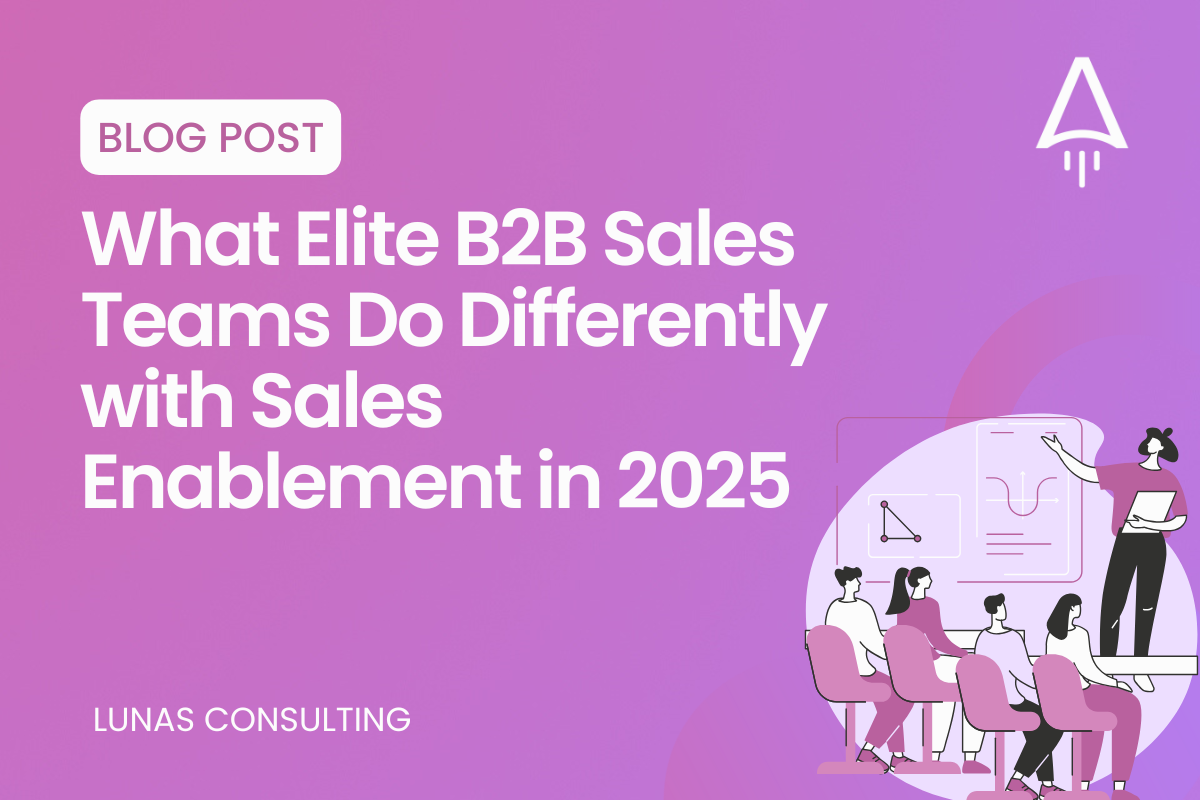What Elite B2B Sales Teams Do Differently with Sales Enablement in 2025
This blog reveals seven best practices that transform sales teams from average performers into revenue-generating machines.
This blog reveals seven best practices that transform sales teams from average performers into revenue-generating machines.

Keeping sales teams productive isn't easy. Markets shift overnight, buyer expectations evolve constantly, and what worked last quarter might fail spectacularly today. Without a structured approach to sales enablement, teams waste time searching for content, struggle with inconsistent messaging, and lose deals to better-prepared competitors.
Yet some organizations consistently achieve remarkable results. Outbound SDRs produce 15 meetings a month, with an 80% show rate, leading to 12 meetings held per month when proper enablement is in place. The difference between these high performers and everyone else? They've mastered modern sales enablement practices that go beyond basic training to create systematic competitive advantages.
Let's break down seven proven best practices that separate world-class sales organizations from those struggling to hit quota. You'll learn exactly how each practice works, when to implement it, and practical tips for making it stick in your organization.
Sales enablement has transformed from a nice-to-have training function into a strategic revenue driver. The old model of quarterly training sessions and dusty playbooks gathering digital dust is dead. Modern enablement operates as the connective tissue between strategy and execution.
The shift from reactive to proactive enablement marks the biggest change. Instead of scrambling to create materials when deals stall, leading organizations anticipate needs before they arise. They track which content accelerates deals, which talk tracks resonate with specific personas, and which skills correlate with quota attainment.

According to a study by Salesforce, 83% of sales professionals believe AI has already improved their ability to engage prospects effectively. This technology integration represents another fundamental shift. AI now powers everything from content recommendations to real-time coaching, multiplying the impact of enablement efforts.
Data-driven decision making has replaced gut instinct and opinion. Every piece of content, every training module, every coaching session generates measurable results that inform future investments. Organizations know exactly which enablement activities drive revenue and which waste resources.
First impressions matter, and nowhere is this truer than with new sales hires. The difference between a rep ramping in 3 months versus 6 months can mean hundreds of thousands in lost pipeline. Modern onboarding programs use data and structure to accelerate time-to-productivity.
Building Competency-Based Learning Paths
Generic onboarding fails because it treats all reps the same. A seasoned enterprise seller needs different development than a junior SDR. Competency-based paths assess existing skills and customize learning accordingly.
Start by mapping the specific competencies required for success in each role:
Assess new hires against these competencies to identify gaps. Then create personalized learning paths that focus on weakness areas while leveraging existing strengths. This targeted approach cuts ramp time by 30-40% compared to one-size-fits-all programs.
The 30-60-90 Day Framework That Works
Structure prevents drift and ensures consistent outcomes. Here's what high-performing organizations include:
Days 1-30: Foundation Building
Days 31-60: Skill Application
Days 61-90: Performance Acceleration
Track progression through clear milestones and gates. Reps shouldn't advance until they demonstrate competency, ensuring quality over speed.
A tip from us: Pair every new hire with both a peer buddy and senior mentor. The buddy helps with daily questions and cultural integration. The mentor provides strategic guidance and career development. This dual support system dramatically improves retention and ramp time.
You may also be interested in: Building a High-Performance SDR Team That Consistently Books Qualified Meetings
Sales content is worthless if reps can't find it, don't trust it, or use it at the wrong time. The average open rate across industries is 42.35% for sales emails, but the right content at the right moment can double engagement rates.

Mapping Content to Sales Stages
Start by documenting your actual buyer journey, not the idealized version in your sales methodology. Where do deals stall? What questions arise at each stage? Which objections kill momentum?
Then audit existing content against these needs:
Awareness Stage Content:
Consideration Stage Content:
Decision Stage Content:
Creating Persona-Based Libraries
Different stakeholders care about different things. The CFO wants ROI and risk mitigation. The end user wants ease of use and time savings. Generic content satisfies no one.
Build content libraries organized by persona with clear guidance on usage:
Make these libraries searchable by multiple dimensions: stage, persona, industry, use case, and competitive situation. The easier content is to find, the more it gets used.
Just-in-Time Delivery Systems
The best content arrives exactly when needed. Modern enablement platforms can:
This contextual delivery transforms content from a static library into an active selling assistant.
Static playbooks fail because selling is dynamic. Every deal is different, every buyer unique. AI-powered playbooks adapt to specific situations, providing relevant guidance exactly when reps need it.
Dynamic Playbook Creation
Instead of one massive playbook trying to cover everything, create modular components that AI assembles based on context:
Qualification Frameworks that adjust based on:
Objection Handling Guides that consider:
Competitive Positioning that factors:
AI analyzes deal characteristics and surfaces relevant playbook sections in real-time. A rep facing pricing objections from a CFO at a 500-person SaaS company gets different guidance than one handling technical concerns from an IT director at a 5,000-person manufacturer.

Real-Time Situational Guidance
Modern conversation intelligence goes beyond call recording to provide live coaching. As calls progress, AI can:
This transforms every rep into a seasoned seller by augmenting their natural abilities with organizational knowledge.
One-and-done training doesn't stick. Research shows that without reinforcement, people forget 70% of training content within a week. Continuous development programs solve this through ongoing, contextual learning.
Microlearning That Actually Works
Break complex skills into digestible chunks delivered consistently. Instead of day-long training marathons, deploy 5-10 minute modules that reps can consume between meetings.
Effective microlearning includes:
Topics should align with current needs. If win rates are dropping in competitive deals, deploy modules on differentiation and competitive positioning. If sales cycles are lengthening, focus on urgency creation and stakeholder alignment.
Simulation and Role-Play Evolution
Practice makes permanent, but only if the practice resembles reality. Modern simulation goes beyond basic role-play to create immersive scenarios.
In 2025, the skills required for appointment setting will go beyond basic sales tactics, and the same applies to all sales skills. Use technology to create realistic practice environments:
Track performance in simulations to identify skill gaps before they impact real deals. A rep struggling with economic buyer conversations in practice needs coaching before meeting the actual CFO.
A tip from us: Create a "skill of the week" program where the entire team focuses on mastering one specific capability. Share best practices, run exercises, and celebrate improvements. This concentrated effort drives faster skill development than scattered training approaches.
You may also be interested in: Critical Outsourced Sales Mistakes That Sabotage Business Growth and How to Fix Them
Flying blind kills sales productivity. Revenue intelligence platforms provide the visibility and insights that enable proactive enablement rather than reactive firefighting.
Real-Time Pipeline Visibility
Know exactly what's happening across every deal, every rep, every day. Modern revenue intelligence tracks:
This visibility enables targeted enablement interventions. If multiple deals stall at the same stage, you've identified a systemic issue requiring training or content. If specific reps struggle with certain deal types, you can provide focused coaching before it impacts the quarter.
Win/Loss Analysis Automation
Manual win/loss analysis happens sporadically if at all. Automated analysis happens on every deal, providing continuous insights into what's working and what's not.
Track patterns across won and lost deals:
Despite a strong 2023 start, 73% of reps missed H2 quotas; now, in 2024, 69% are still falling short on average. Understanding why through systematic analysis enables targeted improvements that reverse these trends.
Predictive Forecasting and Risk Identification
AI analyzes thousands of data points to predict deal outcomes with increasing accuracy. This enables proactive interventions:
The combination of visibility, analysis, and prediction transforms enablement from a support function into a strategic driver of revenue outcomes.
The divide between sales and marketing costs companies millions in lost opportunities. When these teams operate in silos, messaging conflicts, leads go cold, and buyers receive disjointed experiences.

Creating Collaborative Frameworks
Alignment starts with shared objectives that both teams own:
Regular collaboration sessions keep teams synchronized:
Content Co-Creation That Drives Results
Marketing creates content in a vacuum. Sales ignores it. Buyers suffer. Break this cycle through collaborative content development.
Sales provides the insight:
Marketing provides the expertise:
Together, they create content that's both beautiful and effective, driving higher engagement and conversion throughout the funnel.
Operational Integration Excellence
Smooth handoffs prevent dropped balls. Define clear processes for:
Lead Routing and Response:
Campaign Coordination:
This operational excellence ensures marketing's hard work generating demand translates into sales' successful pipeline conversion.
You may also be interested in: Transforming Cold Leads into Sales Opportunities Through Strategic Sequence Design
Great coaching transforms average reps into top performers. But most managers spend less than 20% of their time coaching, and what little they do lacks structure and consistency.
Data-Informed Coaching Approaches
Opinion-based coaching creates confusion. Data-driven coaching drives improvement. Modern managers use intelligence platforms to identify specific development needs:
The first 7 seconds are crucial in any sales interaction. Conversation intelligence can analyze those critical moments across hundreds of calls to identify patterns. Does a rep talk too much early? Do they miss buying signals? Do they handle objections poorly?
Armed with specific examples and data, managers can provide targeted coaching:
This precision coaching accelerates skill development by focusing on specific, measurable improvements.
Individualized Development Plans
Cookie-cutter development fails because every rep has unique strengths and gaps. Create personalized plans based on:
Skill Assessment Results:
Performance Metrics:
Career Aspirations:
Review and adjust plans monthly based on progress and changing needs. What matters is consistent improvement, not perfection.

Group Coaching for Peer Learning
Individual coaching builds skills. Group coaching builds culture. Bring teams together regularly to:
This collaborative approach accelerates learning through peer insights while building team cohesion. Reps learn not just from managers but from each other's experiences.
What gets measured gets managed, but measuring the wrong things manages you into irrelevance. Focus on metrics that directly tie to revenue impact, not activity counts.
Key Performance Indicators That Matter
Track leading indicators that predict success:
Connect these to lagging indicators that prove impact:
21 meetings per month, 62% conversion rate represents the kind of specific, measurable outcome that great enablement delivers. Set similarly concrete targets for your key metrics.
ROI Calculation Methods
Justify enablement investments through clear ROI calculations:
Direct Revenue Impact:
Cost Savings Measurement:
Efficiency Gain Quantification:
Build dashboards that show these connections clearly. When executives see direct lines from enablement activities to revenue outcomes, investment becomes automatic.
Technology enables great enablement but doesn't replace strategy. Too many organizations buy tools thinking technology alone will solve their problems, only to find expensive platforms gathering dust.
Successful Deployment Strategies
Phase your rollout to ensure adoption:
Phase 1: Foundation (Months 1-2)
Phase 2: Expansion (Months 3-4)
Phase 3: Optimization (Months 5-6)
This phased approach prevents overwhelm while building confidence and competence progressively.
Driving User Adoption
The best technology is worthless if no one uses it. Drive adoption through:
Clear Value Communication:
Comprehensive Support Systems:
Accountability Mechanisms:

Remember: adoption is a journey, not a destination. Continuously monitor usage and address barriers as they arise.
Even well-intentioned enablement programs can fail. Understanding common mistakes helps you avoid them.
Technology Over-Investment Without Strategy
Buying the latest platform won't fix broken processes. Technology amplifies what exists, good or bad. Before investing in tools:
One-Size-Fits-All Content Approaches
Generic content satisfies no one. Different roles, industries, and buyer types require tailored approaches. Instead:
Lack of Executive Sponsorship
Enablement without executive support becomes optional. Secure sponsorship by:
Insufficient Measurement Practices
"We think it's working" doesn't cut it. Implement measurement from day one:
Success requires planning, patience, and persistence. Here's how to build an enablement program that delivers sustainable results.
Current State Assessment
Start with honest evaluation:
Survey reps, managers, and leadership for perspectives. Analyze performance data for objective insights. Review competitive positioning for market context.
Priority Identification
You can't fix everything at once. Prioritize based on:
Look for quick wins that build credibility while planning longer-term transformations. A content audit might take weeks but immediately improves productivity. Cultural change takes years but drives lasting advantage.
Success Factors for Implementation
Certain elements consistently separate successful enablement from failed attempts:
Build these factors into your program from the beginning rather than trying to add them later.
You may also be interested in: 7 Appointment Setting Strategies That Fill Your Sales Pipeline with Qualified Meetings
The seven best practices outlined here represent the evolution of sales enablement from cost center to revenue driver. Organizations implementing these approaches systematically see dramatic improvements in performance metrics that matter.
Local businesses increased their revenue by 120% after adding online booking systems to their website. While B2B enablement is more complex than simple booking systems, the principle holds: systematic improvements in how you enable sales directly impact revenue generation.
Start by assessing your current enablement maturity against these practices. Where are the gaps? What would have an immediate impact? Remember, transformation doesn't happen overnight. Pick one or two practices to implement thoroughly rather than trying everything at once.
Focus on building sustainable systems rather than quick fixes. The companies winning in 2025 treat enablement as a strategic discipline worthy of investment, measurement, and continuous improvement. They recognize that enabling sellers to perform at their best is the surest path to predictable revenue growth.

Your next step? Conduct an enablement audit this week. Identify your biggest gap. Build a 90-day plan to address it. Then execute relentlessly while measuring results. Within six months, you'll have transformed your enablement from random acts of training into a systematic competitive advantage.
Interested in improving your skills and learning more about business operations to generate and convert leads? Check out the following articles:
Essential Online Presence Tools Every Business Owner Should Use in 2025
Why Small Businesses Need a Strong Online Presence to Survive and Thrive
How Your Online Presence Functions as Your Most Powerful Business Card
Building a Loyal Online Following Through Strategic Social Media Consistency
How Social Media Transforms Your Digital Strategy and Online Business Growth
10 Time-Saving Strategies for Effective Business Updates Across Social Media Platforms
References:
Gradient Works - B2B Sales Benchmarks 2024
PMG-B2B - B2B Appointment Setting Techniques for 2025
Gungho Global - Sales Appointment Setting Statistics
RevNew - B2B Appointment Setting Best Practices
We have a lot more for you. Click the button below to sign up and get notified when we release more content!
View more